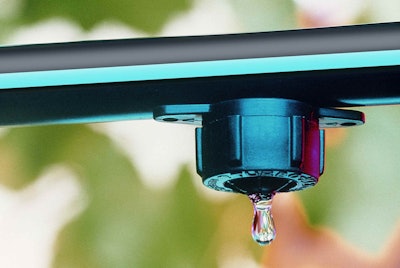 Photo: Toro
Photo: ToroDeciding how irrigation systems should be set up can be one of the most challenging aspects of your job. For plants to grow optimally, they need the right amount of water. Too little and you put them in stress, making them susceptible to pests. Too much and you not only are wasting a precious resource (and your client is footing a higher water bill), but encouraging disease.
Irrigation systems are hands-down the best way to implement efficiency in your watering methods. They can get water where you need it in the amount required. And within the category of irrigation systems, drip irrigation takes efficiency one step further.
“Drip irrigation puts water directly into the soil right at the root system of the plants,” says Dave Laybourn, product manager of the Landscape Drip Division for Rain Bird Corp. “This allows pinpoint accuracy and reduces evaporation when compared with overhead irrigation.”
Placing water precisely where it is needed also means that water is not wasted on the ground surrounding the plant, the foliage of the plant remains dry and, because the water is applied at a slower rate, it’s more efficiently absorbed by the root zone.
More than likely, every property you manage can benefit from drip irrigation. Ideal areas include shrub beds around a building’s foundation. Drip irrigation is also ideal for any plants grown in rows, such as hedges or a line of trees or large shrubs, he adds.
Selling the idea
Now that you know the benefits of drip irrigation, how do you get your clients to buy into an idea that will cost them initially but save them money in the long run? Obviously, you focus on the savings.
First, there are the water savings. “Water costs are going up and landscapers need to be aware that the system they put in today will be using more expensive water in the future,” says Laybourn. “Their clients will appreciate that their new irrigation system is the most efficient possible in the face of rising water costs.”
Next are plant savings. Drip irrigation can literally mean the difference between the success and failure of new plantings because during their first year, water is the driving factor behind either. Securing that initial investment in plants by protecting their survival can amount to a substantial cost savings.
Then there are the labor savings. While lugging the hose around the yard to hand-water plants may appeal to some of your clients, it’s a time drain to most of them. Imagine placing the hose at the base of each plant for 20 minutes. That adds up to a lot of time. And at the end of it, the plants haven’t been watered in a beneficial way.
For your clients who favor sprinklers as the means for watering, you should let them know that these are the least efficient way to water. By the time water travels through the soil there is only enough left to penetrate the top few inches of the root zone. Plus, most of the water lands on the foliage, preventing it from ever reaching the root zone.
All of the cost savings and labor savings associated with drip irrigation come at a relatively low startup price, too. “Drip irrigation systems often include rows of drip tubing installed on grade, then covered over with bark chips or other types of mulch. This is a lot less costly to install than sprinkler pipes that must be trenched in,” says Laybourn. “Plus, drip irrigation often applies less water over a given area, so the irrigation zones can be larger, and fewer, larger zones save cost.”
Getting started
If you are designing a drip irrigation system from scratch, you should first make sure that the water delivered to the system is filtered clean and at a steady pressure of 30 to 40 psi. “Dirty water can plug the drip emitters, and pressure higher than that can cause blow-outs,” says Laybourn. “Plants are expensive, particularly after they have grown up a few years, and you don’t want to risk the health of the plant material by cutting corners on the filter or pressure regulator.” Many irrigation suppliers offer complete preassembled kits that include a valve, filter and pressure regulator, which helps simplify this part of the process.
If you’re adding drip irrigation to an existing system, you’ll still need to add a filter and pressure regulator. Again, look for an irrigation supplier that offers a retrofit unit that lets you add a filter and regulator to an existing pop-up spray body so that drip tubing and emitters can do the job. “Whenever you make changes to an existing irrigation design, however, you will want to look at the water application rate to be sure that the run time is correct,” adds Laybourn.
One of the most popular drip irrigation setups involves in-line drip tubing, according to Laybourn. For this configuration, pressure-compensating drip emitters are built directly into heavy wall tubing. The emitters have regular spacing, usually 12 inches apart, and the tubing is laid out in rows or in a grid. “It is important to have pressure-compensating emitters in the drip line so that each hole delivers the same amount of water, regardless of fluctuating pressure, resulting in the best uniformity of water delivered to the soil,” says Laybourn.
Where do you go from here?
While there is much more to know about the actual installation of a drip irrigation system, hopefully this information will get you moving in the right direction. For more information, contact the irrigation supplier of your choice or the Irrigation Association.
Remember, drip irrigation is all about accuracy: getting the right amount of water exactly where it is needed while avoiding overspray and evaporation. “Over the years, manufacturers have worked hard to make drip irrigation simple for landscapers and customers,” says Laybourn, “all while improving the reliability and durability of drip equipment.”











